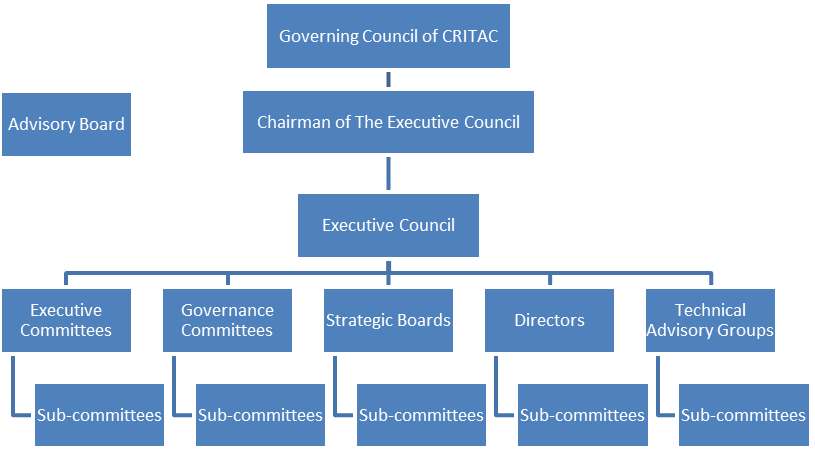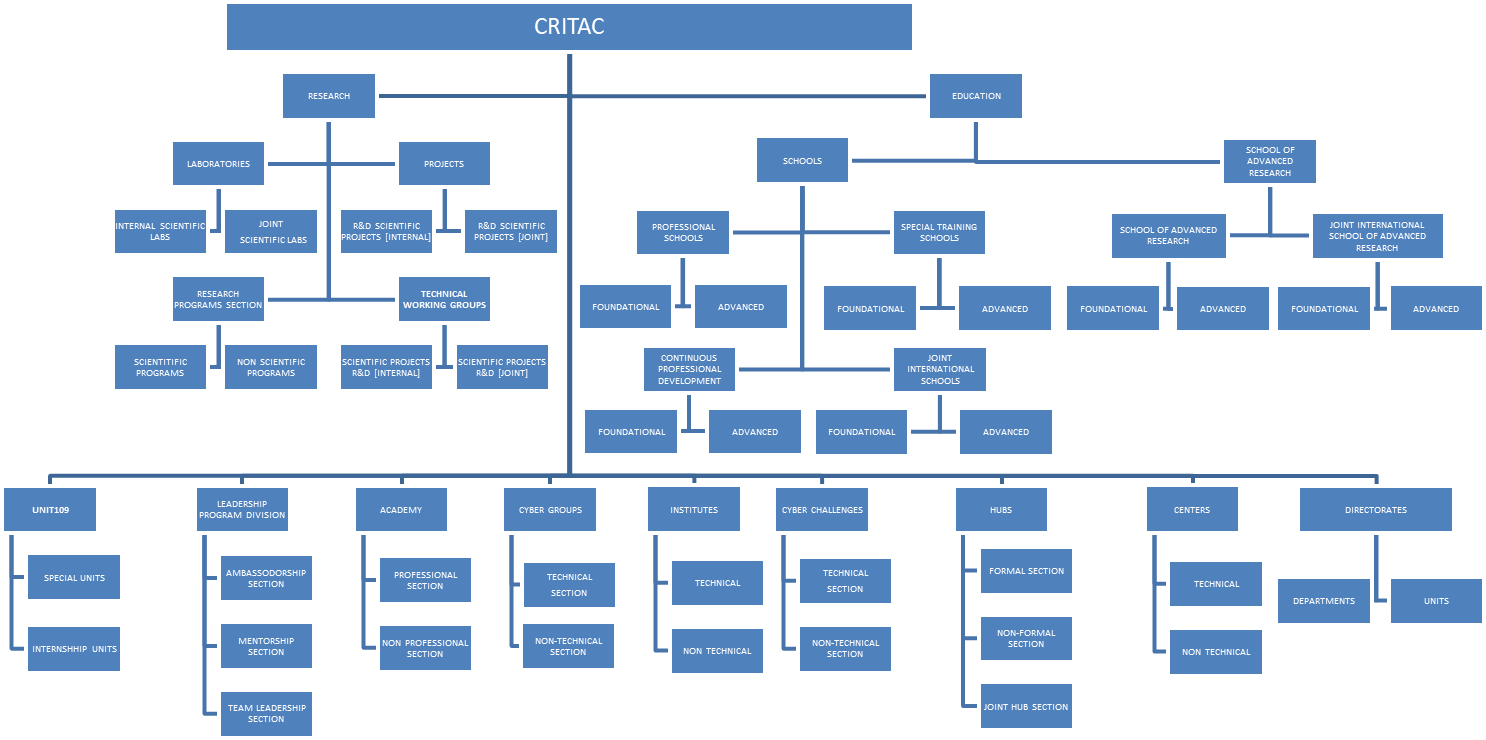CRITAC Strategic Triage

Industry:
CRITAC aims to foster robust partnerships with industries, providing technological solutions, innovations, and insights to address pressing challenges. By engaging industry players, CRITAC ensures that its research outputs are not only theoretical but also practical, catering to real-world applications. This symbiotic relationship is crucial for driving technological adoption and creating value in commercial settings.
Research:
CRITAC is committed to research and innovation. Its research arm seeks to explore technological solutions, pushing the boundaries of knowledge in fields such as forensic sciences, health, automation,cryptography, artificial intelligence, cybersecurity etc. This research is directly informed by industry needs and academic theories, creating a dynamic feedback loop that enhances the quality of both research and its practical applications.
Academia:
As a research-driven institution, CRITAC values its ties with academic institutions. Academia provides the theoretical foundations and skilled human capital necessary for sustained research and innovation. By collaborating with universities and research institutions, CRITAC ensures that its projects are grounded in rigorous academic principles while also creating opportunities for the training and development of future leaders in technology and research.
CRITAC Vision, Mission, and Strategic Direction
Vision
To be a globally recognized center of excellence, driving innovation, research, and education that catalyzes transformative solutions for a sustainable and secure future.
Mission
CRITAC is committed to advancing knowledge through research, fostering innovation, and providing high-quality education and training. We strive to empower individuals and communities by addressing the most pressing challenges in science, technology, artificial intelligence, cybersecurity, and leadership, with an unwavering commitment to ethical practices and global collaboration.
Strategic Direction
- Innovative Research and Development: Lead in scientific and technological research by establishing advanced laboratories and fostering collaborations that drive breakthrough discoveries. Focus on both foundational and applied research that addresses global challenges, with an emphasis on sustainability, security, and societal impact.
- Comprehensive Education and Training: Offer a diverse range of educational programs from foundational to advanced levels, including specialized training, professional development, and leadership programs. Ensure that our curriculum is continuously updated to reflect the latest advancements and industry needs, providing learners with the skills and knowledge necessary to excel in a rapidly changing world.
- Global Collaboration and Partnerships: Strengthen international collaborations with academic institutions, industry leaders, and government agencies to expand CRITAC’s impact. Engage in joint research initiatives, exchange programs, and international conferences to share knowledge and foster innovation on a global scale.
- Sustainability and Ethical Responsibility: Integrate sustainability and ethical considerations into all aspects of CRITAC’s operations, from research and education to governance and community engagement. Promote practices that contribute to environmental stewardship, social equity, and responsible innovation.
- Cybersecurity Leadership: Establish CRITAC as a leader in cybersecurity and artificial intelligence education, research, and policy development. Address emerging areas through research, the development of technical and non-technical solutions, and the training of the next generation of computing professionals.
- Community Engagement and Impact: Actively engage with local and global communities to translate research and innovation into practical solutions that improve lives. Promote inclusive practices that ensure diverse perspectives are represented and foster a culture of continuous learning and mentorship.
- Organizational Excellence: Continuously improve CRITAC’s operational efficiency, governance structures, and leadership practices to ensure the organization remains agile, responsive, and effective in achieving its goals. Invest in the professional development of staff and leadership to maintain a high standard of excellence across all divisions.
CRITAC aims to not only advance knowledge and innovation but also to make a meaningful and lasting impact on the world, contributing to a future that is more secure, sustainable, and equitable for all.
CRITAC GOVERNANCE STRUCTURE

Governance Structure of CRITAC
The governance structure of (CRITAC) is designed to ensure effective leadership, oversight, and strategic direction. The structure is hierarchical, allowing for clear lines of authority and accountability while also fostering collaboration and specialized focus across various domains of the organization.
Governing Council of CRITAC
At the apex of CRITAC’s governance structure is the Governing Council of CRITAC body. This entity is responsible for the overall leadership and governance of the organization. It sets the strategic vision, ensures adherence to CRITAC’s mission, and provides oversight for the entire organization. The Governing Council of CRITAC is the ultimate authority, making critical decisions that shape the future of the organization.
Advisory Board
The Advisory Board operates alongside the Governing Council of CRITAC, offering expert guidance and strategic advice. This board comprises seasoned professionals and thought leaders who provide insights on industry trends, potential challenges, and opportunities. While the Advisory Board does not have direct decision-making authority, its recommendations are highly valued and often inform the decisions made by the Governing Council of CRITAC and the Executive Council.
Chairman of The Executive Council
Reporting directly to the Governing Council of CRITAC is the Chairman of The Executive Council. The Chairman is the senior-most executive responsible for the day-to-day management and operational execution of CRITAC’s strategic plans. This role is pivotal in bridging the gap between the Governing Council of CRITAC and the Executive Council, ensuring that the organization’s activities align with the strategic goals set by the governing body.
Executive Council
The Executive Council is the central body responsible for implementing the strategic directives from the Governing Council of CRITAC. It oversees various operational and functional areas of the organization. The Executive Council acts as the coordinating hub, ensuring that all branches of the organization work harmoniously towards common objectives.
Executive Committees
Under the Executive Council, Executive Committees are established to focus on specific operational areas. These committees are tasked with executing policies, managing resources, and ensuring compliance with organizational standards. Each committee may have its own Sub-committees that handle more specialized tasks within the broader remit of the Executive Committees.
Governance Committees
The Governance Committees focus on maintaining the integrity and accountability of the organization. They ensure that CRITAC’s governance practices are robust, transparent, and aligned with best practices. These committees also have Sub-committees to handle specific governance-related issues such as ethics, risk management, and regulatory compliance.
Strategic Boards
Strategic Boards are specialized groups within the Executive Council that focus on long-term planning and strategic initiatives. They analyze market trends, assess risks, and identify opportunities that can propel CRITAC towards its goals. These boards work closely with the Governing Council of CRITAC to align their strategies with the overall mission. Like other entities, Strategic Boards also manage Sub-committees to delve deeper into specific strategic areas.
Directors
Directors are responsible for overseeing specific departments or divisions within CRITAC. They ensure that their respective areas operate efficiently and effectively, meeting their objectives in line with the organization’s broader goals. Directors are supported by Sub-committees that handle the operational details within their departments.
Technical Advisory Groups
The Technical Advisory Groups provide specialized knowledge and technical expertise to support CRITAC’s operations. These groups are essential for ensuring that CRITAC’s technical strategies are cutting-edge and that its projects are technically sound. They too have Sub-committees that focus on specific technical aspects, allowing for in-depth analysis and problem-solving.
CRITAC’s governance structure is designed to be both comprehensive and flexible, enabling the organization to respond effectively to challenges while maintaining a clear focus on its strategic goals. Each level of the structure, from the Governing Council of CRITAC down to the Sub-committees, plays a crucial role in ensuring the organization operates efficiently, ethically, and in alignment with its mission. The inclusion of advisory bodies and technical groups ensures that CRITAC remains innovative and forward-thinking, while the hierarchical structure ensures clear lines of accountability and decision-making.
CRITAC ORGANOGRAM

CRITAC
At the top of the structure is CRITAC, which represents the overarching organization with the vision, mission, and strategic direction. All other units, divisions, and sections operate under the umbrella of CRITAC.
Research Division
The Research division is a major component of CRITAC, focusing on the creation and management of scientific knowledge. This division is further broken down into the following sections:
- Laboratories
- Internal Scientific Labs
- Joint Scientific Labs
- Projects
- R&D Scientific Projects [Internal]
- R&D Scientific Projects [Joint]
- Research Programs Section
- Scientific Programs
- Non-Scientific Programs
- Technical Working Groups
- Scientific Projects R&D [Internal]
- Scientific Projects R&D [Joint]
Education Division
The Education division is dedicated to training, professional development, and advanced research. It is composed of several specialized schools and programs:
- Schools
- Joint International Schools
- Foundational
- Advanced
- Special Training Schools
- Foundational
- Advanced
- Professional Schools
- Foundational
- Advanced
- Continuous Professional Development
- Foundational
- Advanced
- School of Advanced Research
- Joint International School of Advanced Research
- Foundational
- Advanced
- School of Advanced Research
- Foundational
- Advanced
Specialized Units
Unit109 and the Leadership Program Division are specialized units that focus on specific operational areas:
- Unit109
- Special Units
- Internship Units
- Leadership Program Division
- Ambassadorship Section
- Mentorship Section
- Team Leadership Section
Academy
The Academy is divided into two main sections:
- Professional Section
- Non-Professional Section
Cyber Units
The Cyber Groups and Cyber Challenges sections focus on cybersecurity and related fields:
- Cyber Groups
- Technical Section
- Non-Technical Section
- Cyber Challenges
- Technical Section
- Non-Technical Section
Hubs, Institutes, and Centers
These units provide focused areas of expertise and collaboration:
- Hubs
- Formal Section
- Non-Formal Section
- Joint Hub Section
- Institutes
- Technical
- Non-Technical
- Centers
- Technical
- Non-Technical
Directorates
At the base of the structure, Directorates are responsible for managing the day-to-day operations within their respective domains:
- Departments
- Units
This comprehensive structure of CRITAC allows for a clear delegation of responsibilities, ensuring that each area of focus—whether it be research, education, cybersecurity, or leadership—is managed efficiently. The hierarchical arrangement ensures clear lines of communication and accountability, while the division into specialized units allows for expertise to flourish in focused areas. The structure is designed to foster collaboration, innovation, and leadership across all levels, ensuring CRITAC can meet its strategic goals effectively.